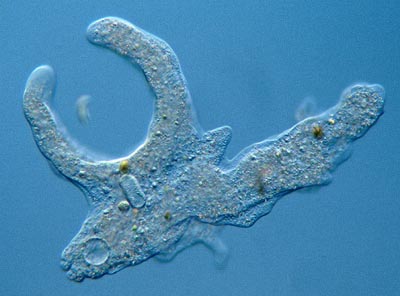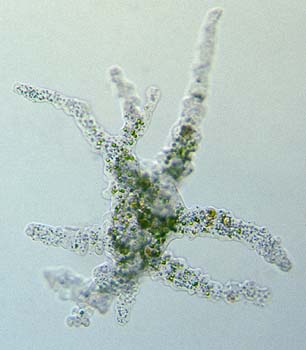LOCOMOTION AND FEEDING
by Wim van Egmond, The Netherlands

|
LOCOMOTION AND FEEDING by Wim van Egmond, The Netherlands |
 |
|
| To be able to understand their mechanism of locomotion we have to know a bit more about the amoeba's anatomy. The cytoplasm inside the cell is capable of changing into different states. It can turn very easily from a fluid into a solid state and vice versa. The fluid state of the cytoplasm is called plasmasol, the more solid state is called plasmagel. When the organism locomotes the plasmasol flows through the center of the cell towards the front. When the plasmasol moves to the sides it becomes solid again. This way the cell can propel itself as a whole but can also send pseudopodia in many directions. |
| It
is this pseudopodia movement that enables the amoeba to capture prey. These
two images of Amoeba proteus shows how a fast moving ciliate is
surrounded by quick developing pseudopodia. The amazing thing is that the
amoeba don't touch the ciliate until it can't escape. Usually the pseudopods
form a kind of 'dome' that makes escaping impossible. They have to have
some sort of chemical detection since they notice a prey without having
to touch it.
A pretty clever trick for a simple 'blob'. It becomes even more of a mystery. Amoebas seem to use different engulfing tactics to suit the various types of prey. They can detect if a prey needs a fast approach (ciliates) or can be feasted on as a slow meal (immobile algae) |

Surprisingly fast pseudopods close in on a small ciliate. Notice the cell nucleus and the water expelling vesicle |
|
 |
There
is another method of transportation some amoebas are able to perform. When
Amoeba proteus is disturbed (this happens often when you examine
it since scooping up will disturb the amoeba) it will change into a shape
like a star with long pseudopods extending into all directions. This shape
allows it to free float in the water.
The image shows how Amoeba proteus changes into its normal appearance after being disturbed |
||
|
Page 1: Amoebas are more than just blobs
|
|
|
All comments to the author Wim van Egmond are welcomed.
Find
out more about microscopic pond life on The
Smallest Page on the web
The
Pond Life Identification Kit may help
you identifying small freshwater organisms
Visit Wims home page for links to his many web pages on microscopy
Please report any Web problems or
offer general comments to the Micscape
Editor,
via the contact on current Micscape
Index.
Micscape is the on-line monthly magazine
of the Microscopy UK web
site at Microscopy-UK